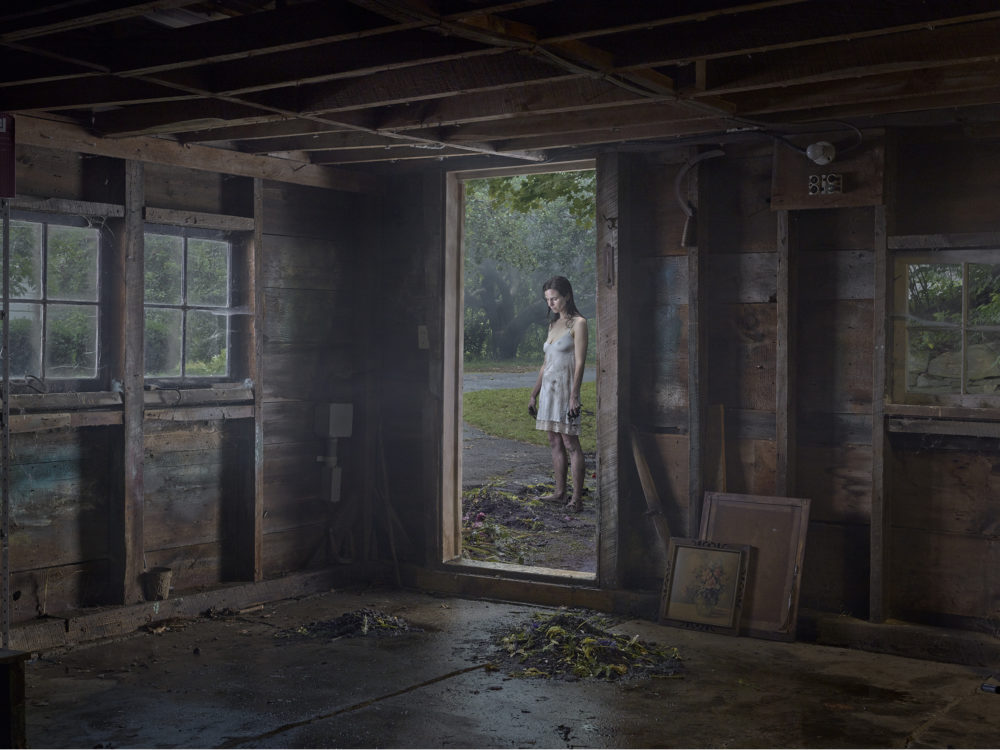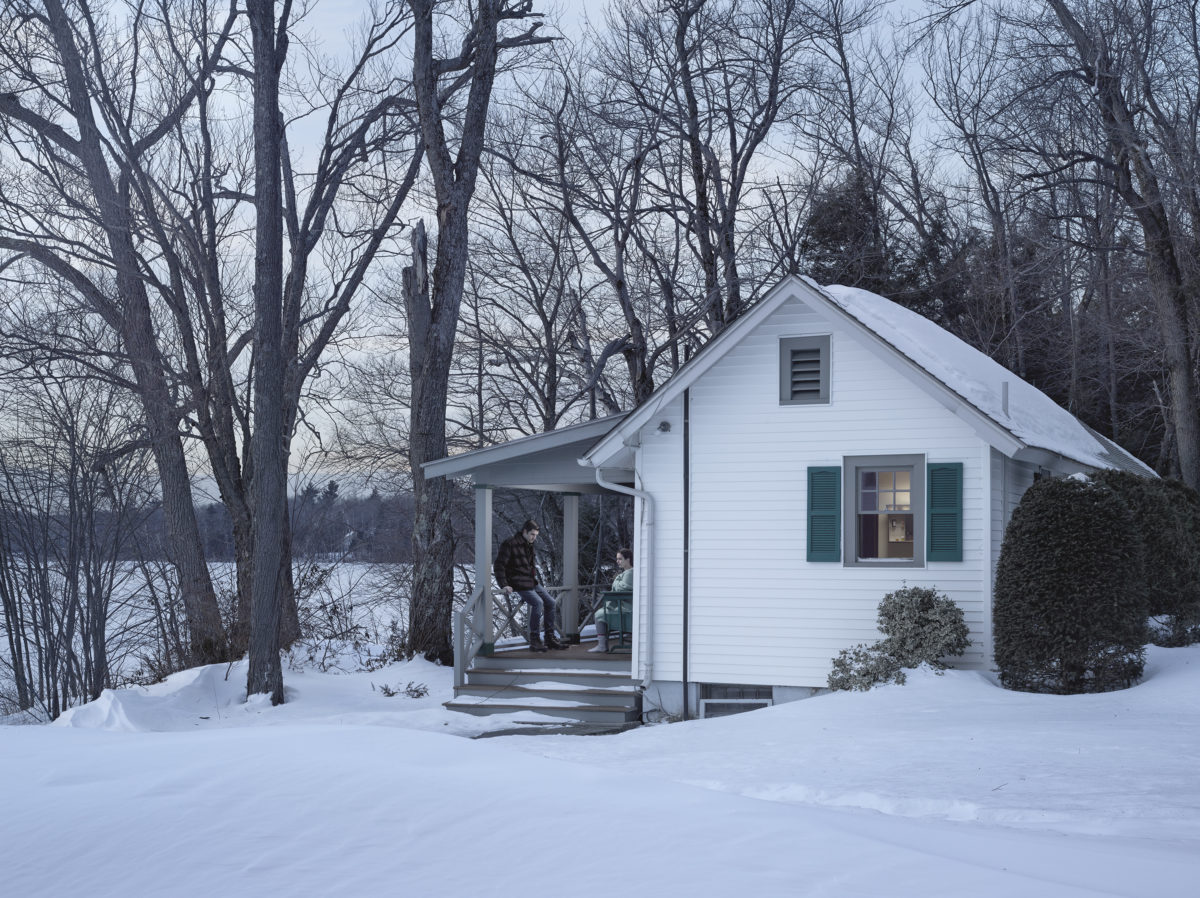
“Mrs Merriam came to her back window, which saw Miss Fielding’s house and Pepper Street beyond, and looked anxiously down Pepper Street,” writes Shirley Jackson at the opening of The Road Through The Wall. “Mrs Merriam’s clock had stopped; it was easier to look out the back window than go upstairs to the bedroom clock.”
It seems the clock has stopped in every one of Gregory Crewdson’s photographs. Set in the town of Becket, Massachusetts, the new body of work Cathedral of the Pines has no reference to a recognizable era and turns it into a fictional small-town landscape of tense bodies, staring faces and odd happenings. Currently, this landscape and all its quiet drama fills the rooms of The Photographers’ Gallery, as for the first time in its history the gallery dedicates all three of its floors to the work of one artist. I chatted with Crewdson about the exhibition.
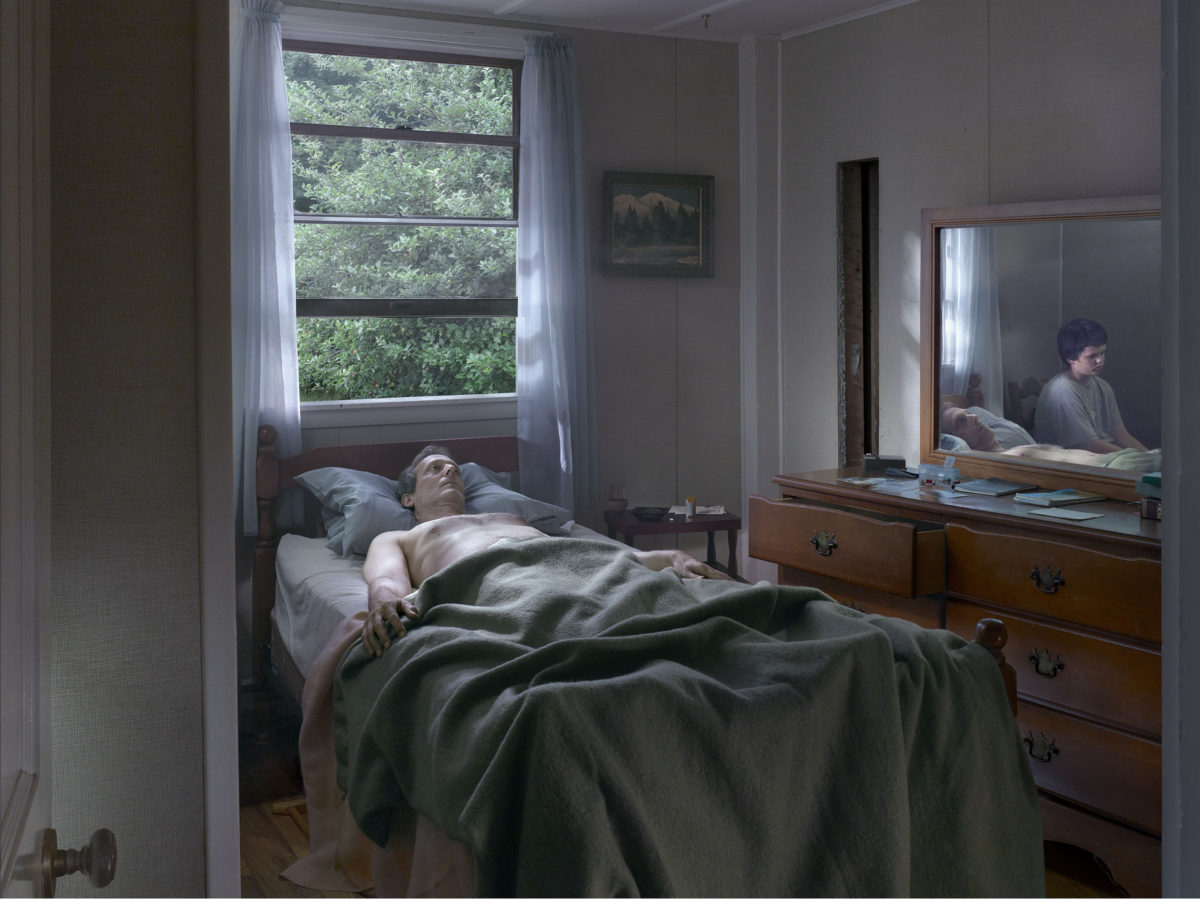
This project moves on from previous works, which are set more in urban or suburban landscapes, into natural landscapes, forests. Was that a conscious decision?
Yeah, well it seemed very necessary at the time. I had just moved out of New York, and to the church I currently live in, where I have my studio. I was trying to recover from a very difficult divorce and I was spending a lot of time, as I still do, doing long distance swims – in fact I just returned from one, at Upper Goose Pond in Becket, and also cross-country skiing in the woods up there: that’s how the whole body of works kind of came together. So the town of Becket barely exists. It’s not even a town, really, it’s mostly woods and the occasional house. So because I was spending so much time up there, and because I have a history connected to that place, I decided to make Cathedral of the Pines in those locations.
So you don’t ever choose locations with the idea “it has this historical connotation”, or anything like that?
Becket did have historical connotations to my own life. We used to go up there when I was a child, and the family had a little cabin in Becket. But that’s just meaningful to me, really. In the end, I want the picture to feel like it could be anywhere.
Oh yeah, that’s interesting, because you get this sense of nostalgia. Though the imagery and the landscape are so irrelevant to my own childhood, I still get this sense of some kind of memory that I didn’t really have.
Yeah, I really like that, because part of what I try to get at is having the feeling of the uncanny: something that’s both familiar and strange at the same time. There’re no signifiers of contemporary life in my pictures: the are no cell phones, no contemporary clothes or cars. It all kind of exists outside of time, really, and that’s purposeful.
“It’s about lone figures trying to make a connection with the world. I feel like I can relate to that.”
People make much of your references to Edward Hopper and David Lynch, but your photos are full of old books. Do you have any literary references?
First and foremost, I just love the way they look, hard-cover books from a particular period. Then a lot of great American literature has been produced in this area where I live. Edith Wharton lived in Lenox and wrote Ethan Frome. Melville lived in Pittsfield and wrote Moby Dick here, and Hawthorne lived nearby. And again, its that idea that this place has a kind of pre-existing mythology, a fictional past, in a way, that I’m struck by.
That’s great. I don’t know if you like Shirley Jackson?
Oh, yes, yes.
I always get that same atmosphere coming through in her work.
Oh yeah, The Lottery, right, and We Have Always Lived in The Castle?
And there’s one called The Road Through the Wall, I don’t know if you’ve read it?
Oh no, I don’t know that.
It’s about this suburban neighbourhood, and nothing really happens, but everyone’s very tense all the time.
It’s called The Road Through The Wall? I’m gonna have to check that out. I like that title.
Yeah, I mean, even the title speaks of your images, really.
Yeah exactly! Cool.
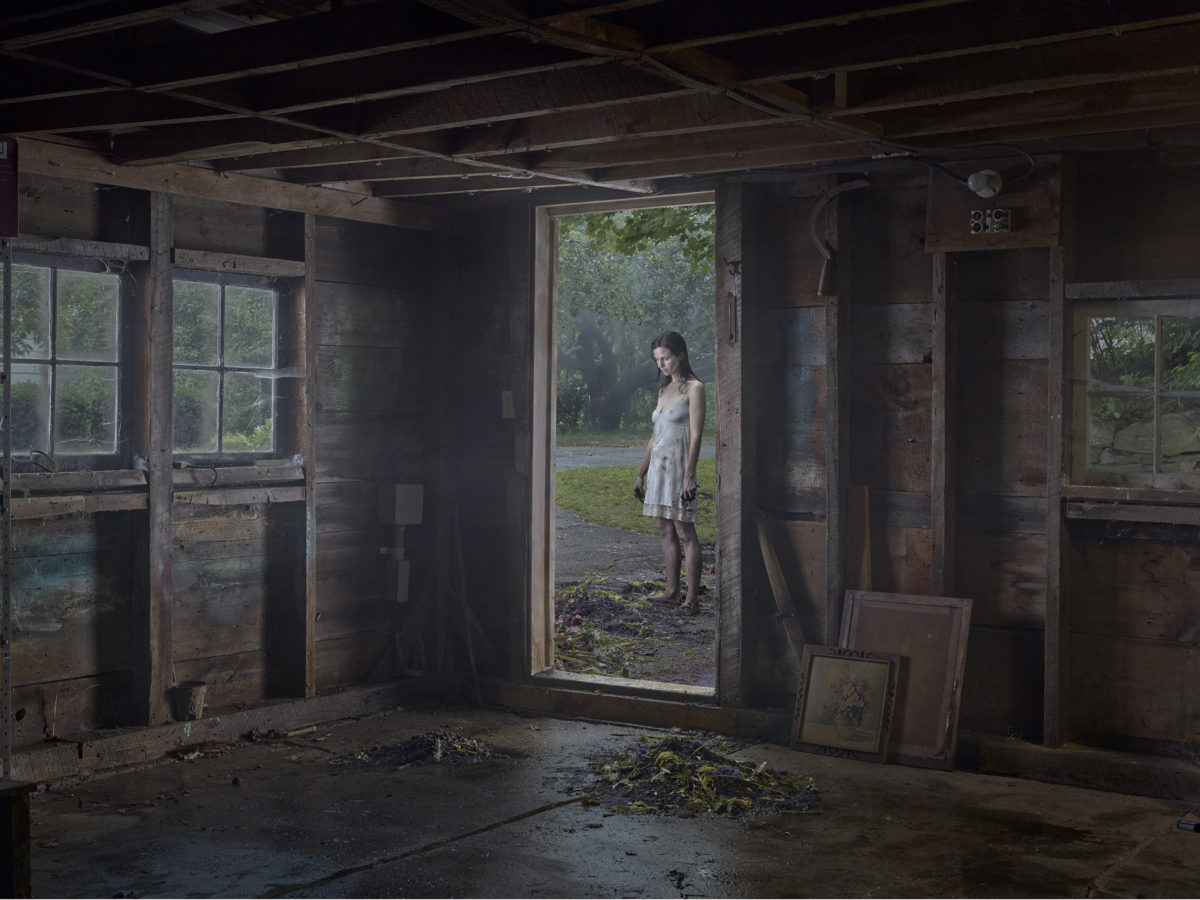
So going back to the church, how long ago was it that you moved in?
Oh, it was about six or seven years ago now.
And the body of work is called Cathedral of the Pines; would you say there is a sense of spirituality, are you trying to focus on that idea?
Yeah, I think it’s sort of an interesting confluence. I’m not religious in any practical way, but I moved into the church in a very dark moment in my life, and it felt very powerful to move in there. Cathedral of the Pines was a trail name when we were skiing. But I think I was open to this idea of searching, trying to establish some kind of meaning and order in my life. And on a fundamental level photographs are concerned with light, and light is by its very nature illuminating, and so there’s almost an automatic connection between the act of making photographs and some kind of spiritual endeavour.
Yes. It brings it back to you saying you don’t actively try to make work that responds to what’s going on in the outside world. I mean, there’s a lot of scary stuff going on in the world right now…
Yes. It’s so easy, particularly in times like now, for work to become over-didactic or simplified. And we already have the news of the day. Artwork has another job, and that’s to quietly express these things but also to suggest some possibility of hope, through the aesthetic act. If my pictures were just completely bleak they’d be less interesting as photographs. To me what’s interesting is their aesthetic, their ambition to try to be beautiful and mysterious objects – that, I think, in the end, is what makes them what they are.
“I wanted the pictures to have a greater degree of intimacy, even though they will never be seen as cosy.”
A practical question: Photography is often seen as a solo pursuit, and yet you work with so many people. Did that come naturally to you? Did you always feel like a film director more than a photographer?
I think, in the end, my process is as lonely as any other way of making pictures. It starts with me, just myself, wandering around, driving around in circles, isolated from the world, and I just think that by its very nature, photography is a lonely endeavour, and sometimes when there’s always people around it makes it even lonelier, you know. It’s hard to describe why, but it maybe has something to do with the content of the work: it’s about lone figures trying to make a connection with the world. I feel like I can relate to that.
Have you ever found it difficult to work with people?
At times it can be cumbersome. The good news is, I work with the same primary group over and over again. I’ve worked with my lighting director for twenty years, and the same camera guy and line producer. Juliane and I work very closely together, so there’s a shorthand where we communicate things directly, without even speaking sometimes. When there’s a problem you just have to talk about it. The main thing when you’re working with a group is you have to allow everyone to do their job, because they do it better than you could possibly do it. But in the end, the picture has to reflect something very particular and very personal, so there’s a contradiction there and it either works or it doesn’t.

Is it right that all of the people in Cathedral of the Pines are friends and family?
Yeah, or at the very least acquaintances. All of them are people I know and care about and certainly everyone is from this area. That was very personal, I wanted the pictures to have a greater degree of intimacy, even though they will never be seen as cosy. There’s always that necessary distance in my pictures.
So everyone is from Becket, but then there’s The Mattress (2014) and The Disturbance (2014), and they both have outside forces in them: police forces, fire brigades. Why did it feel necessary to include those elements in the story?
I always feel like there’re certain riddles in all the pictures. In The Disturbance we see the lone woman in her living room, looking onto an event. Whatever is happening, it’s off-screen, off-frame. The Mattress is the same. A certain hallmark of this body of work is to never have whatever story line there is be literal. It always has to remain a question, abstract in a way.
Currently you’re working on something you’ve got coming up, right?
Yeah, we’re working on a movie, actually. It’s something that’s been in the works for a couple of years and it will be shot up here. Juliane and I wrote the screenplay, and it will very much feel like my world in a movie.
Sounds really exciting. Does it feel good to be making a full movie now rather than just stills?
Well right now it feels good because I’m not actually doing it. So it all seems great!
Haha, well the dream of it anyway?
Yeah, the dream of it’s really great, the process of writing the screenplay has been a really interesting challenge. But you’ll hear more about it.
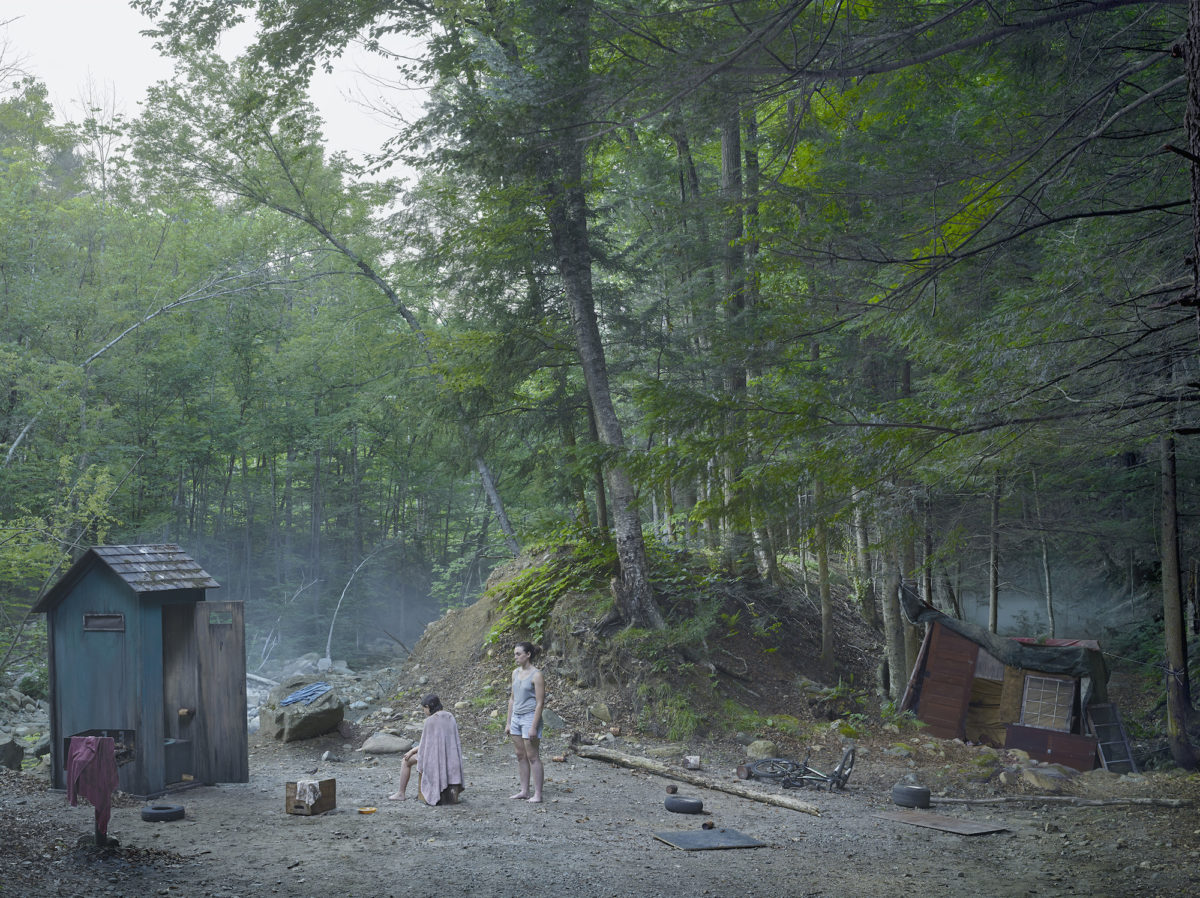
Cathedral of the Pines
Until 8 October at The Photographers’ Gallery, London
thephotographersgallery.org.uk
